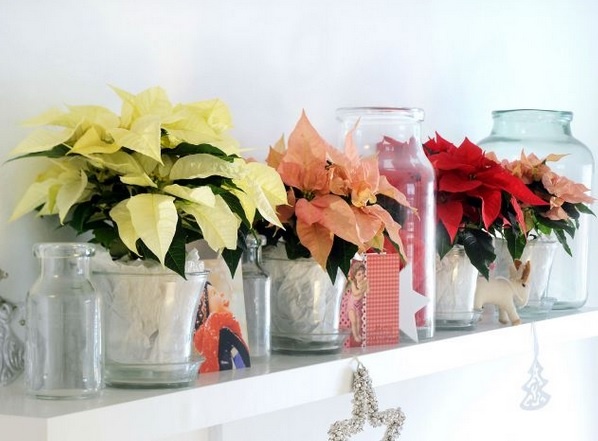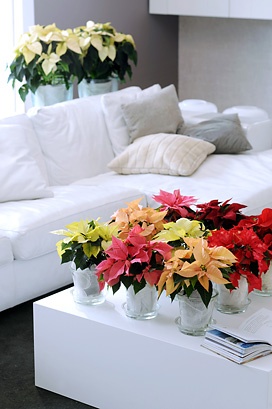Thinking about Christmascoming soon, we interviewed some of our customers in a competition where they had to nominate their favorite Christmas flower. We were not surprised to see that for 8 out of 10 people, poinsettiais their Christmas flower of choice. Extremely popular in the US, in Canada and Mexico, the poinsettia called also the Christmas Star is the best seller during the holiday season. In the US more than 66 million of plants are sold every year where they contribute over $250 million to the US economy at the retail level. In Europe more than 30 million are offered at Christmas.
Important facts to know about poinsettia:
- Poinsettias are part of the Euphorbiaceous family
- Over 100 varieties of poinsettias are available, in different colors, from the traditional red, to white, pink, burgundy, salmon or multi-colors, marbled and speckled. Some of them have famous names such as “premium Picasso” or “Monet Twilight”.
- The name Poinsettia is due to John Poinsett, an American botanist, physician and the first United States Ambassador to Mexico. He introduced the plant to the US from Mexico where he discovered that plant in its natural environment.
- In Mexico, the poinsettia is a perennial plant that can grow 10-15 feet tall in average.
- December 12th is the Poinsettia Day, which marks the death of John Poinsett in 1851. Popular in the US, this day is a symbol to offer peace and harmony for the holiday season.
- You can offer a poinsettia to thank a friend or a neighbor for the good time shared during the year and the services offered. On the other hand, poinsettia is also a gift you can offer to someone you want to be forgiven.
- The colored parts of the poinsettias that most people think of as the flowers are actually colored bracts. The leaves are not the flowers!
Aztec mythology
Poinsettia are grown in plantations in southern countries, but has its origins in Mexico, where it grows wild. According to the Aztec mythology there was a goddess who died of a broken heart. Her blood dripped down on the poinsettia and it thus received its original red color. The poinsettia arrived to us in Europe via the USA where it was introduced in the mid-1900s. The wild poinsettia is a large shrub, but thanks to cultivation a number of variants have been developed that are suitable as a house plant.
Tips
If you want to buy or offer a poinsettia, you should select a plant with dark green foliage. Be careful to the signs given by the leaves! Fallen, yet, low or damaged leaves indicate poor handling or fertilization, lack of water or a root disease that may affect your plant life. The colorful flower bracts should be in proportion to the plant and pot size. One sign that the poinsettia is doing well and will last is that the flowers are in bud and look fresh. Always be careful with pets and children, as the poinsettias should not be ingested or you may feel nauseous and vomit.
Care
You just received a poinsettiaand you want to replant it in your garden? Bad idea! This tropical plant does not like our cold, wet soils and it’s better to keep it inside. Poinsettias are very sensitive to cold and they may suffer from a thermic shock that may be fatal. As soon as the temperature goes down to 15 degrees or below it can hurt the plant and it starts to lose its leaves. If you buy a poinsettia and will transport it outside in the cold for some time, you should make sure it is well wrapped to spare it from the cold. Place your poinsettia in a bright spot, but not directly facing south. The soil should be kept slightly moist, both excessive watering and dehydration will hurt the plant.
During the flowering period:
- Regular watering with warm water. Don’t let water stagnate in the pot, you can also add gravel or little stones in the pot. Make sure that the soil is always moist.
- Place in a room with temperature 16-20 °
- Adequate lighting (at least 10 hours per day) but not in direct sunlight
- do not give the plant any fertilizer.
Tip: If the leaves turn white, it’s too much water & if the leaves turn yellow it’s not enough water
After the flowering period:
- Little watering or even stop it for a while
- cut about 5 to 10 cm of the stem to stimulate further blooms
- provide fertilizer once a month
- give fresh soil
- To get new brachts (colored leaves) it is imperative to keep the plant in total darkness for at least 12 hours per day for several weeks





